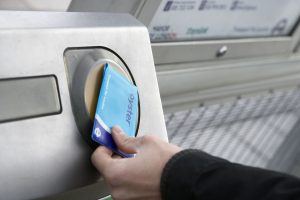Contactless point-of-sale debit and credit card transactions are barely a blip on the U.S. payments screen, but on London’s vast public-transportation system, payments from contactless cards or smart phones now account for half of all pay-as-you-go fares on subways and rail lines, system operator Transport for London reported Tuesday.
Contactless payments on buses and trams aren’t far behind, accounting for 45% of pay-as-you-go journeys on those modes, TfL said. Pay-as-you go fares are cheaper than the one-day passes TfL offers, and riders using contactless media can have their fares capped weekly.

TfL introduced contactless payments on buses in 2012 and in 2014 on the Tube—the subway system—and rail lines. Two years ago, contactless payments accounted for only 25% of journeys, TfL said. Now, about 17 million journeys per week are paid for with contactless fare media.
Besides TfL’s Oyster card, most general-purpose debit and credit cards in the United Kingdom are now issued with contactless capability and usable on TfL. The system also accepts all American Express and many contactless-enabled Visa and Mastercard cards issued in other countries. The vast majority of contactless transit transactions come from cards, but one in eight journeys, or about 12.5%, originate on mobile devices, according to TfL.
Contactless payments are a natural for transit because of their high speed. In an arrangement with fare-systems developer Cubic Transportation Systems, TfL is licensing its contactless ticketing technology to other transit systems throughout the world as they upgrade their fare operations, including New York, Boston, Miami, and Sydney, Australia.
In the United States, payment executives say transactions from contactless-enabled cards and mobile wallets accounted for about 1% of general-purpose POS purchases last year. They hope to see that share rise as issuers slowly embrace dual-interface cards that support both contact EMV chip-based payments and contactless ones using near-field communication technology, and as NFC-enabled mobile wallets gain payment share.






